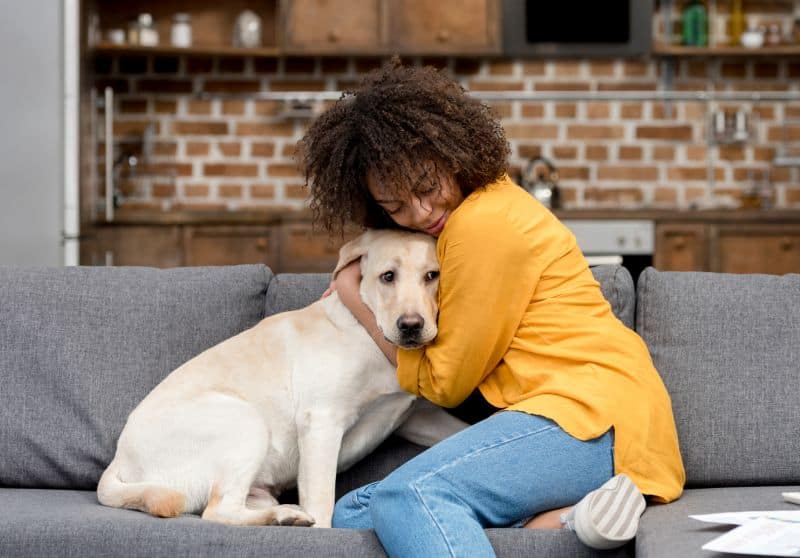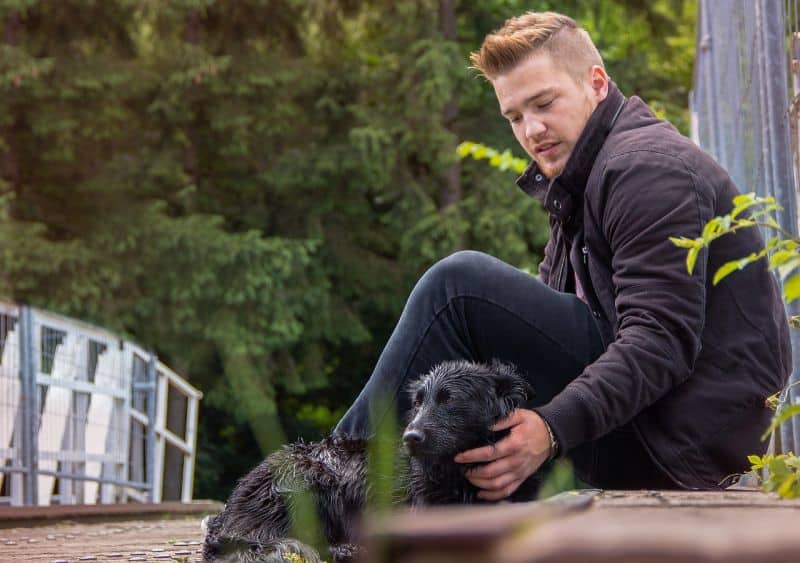No pet parent wants their dog to be in pain. However, because they naturally attempt to hide their suffering and are unable to communicate their pain to us, it is our responsibility to spot the subtle signs and get them the assistance they require.
There are numerous behaviors and physical modifications that can suggest pain in dogs. Learn how to spot the symptoms of pain in dogs, the causes of pain, what you can do to help, and how to talk to your vet about your concerns.
Signs That Your Dog is Dying
Dogs still possess a lot of their primal instincts from when they were wild. As a result, many people will attempt to conceal their illness.
Many dogs will naturally try to hide their pain or any symptoms of illness because in the wild, showing signs of harm or terminal illness makes an animal a target for predators.
This can make it challenging to tell whether your dog is getting close to the end of his life. Sadly, you frequently won’t notice until your dog is very close.
But there are a few indicators you can look for to tell if your dog is getting close to the end of their days.

A dog may start to become disinterested in his surroundings as he nears the end of his life. This is especially true for dogs that have a chronic, long-term illness.
He might stop jumping up to greet you at the door and his beloved toys may begin to collect dust.
Actually, this is frequently one of the first (and saddest) indications that your dog’s quality of life is starting to decline. Unfortunately, this is a typical sign of your dog’s body slowing down.
There are typically a variety of causes for a loss of interest in previously enjoyable things and activities.
These elements may make it much simpler for your dog to stay in bed all day than to engage in his favorite activities.
As they get older and closer to the end of their lives, dogs frequently lose their coordination. Their balance may be affected because they lack the muscle strength they once had.
Additionally, they might struggle with distance perception or have poor vision. These factors can make them much clumsier than usual.
Numerous illnesses, such as dehydration, can also result in a loss of coordination. It may only be dehydration if your dog exhibits gastrointestinal symptoms followed by a loss of coordination.
However, it’s concerning if your dog exhibits more than one of these symptoms.

Many of the symptoms of depression can be seen in dying dogs.
This isn’t necessarily a sign that your dog is aware that he is dying. Instead, it is likely that he simply doesn’t feel well.
He may, for example:
Dog depression can be treated in other situations, but as your dog gets closer to the end of his life, it might be more difficult to deal with.
Some depressed dogs are treated with medication, but if your dog is very old, the medication may not work as well for him. It’s crucial to discuss your options with your veterinarian.
Normal bodily functions may start to malfunction in a dog who is very close to passing away. This can cause him to breathe in an odd manner.
This is actually true for humans too. If you’ve ever visited a loved one on their deathbed, you may be familiar with the irregular breathing that frequently occurs during the final hours of a person’s life.
Your dog’s breathing may be very slow or very fast. It might start out normal for a while before becoming labored and then going back to normal. He might also just have to exert himself to get the air in and out.
If you haven’t already, call your veterinarian as soon as your dog starts having breathing issues. This may indicate a condition that can be treated with the appropriate care.
This is frequently one of the final indications that a dog is passing away. However, it may continue for a while before your dog actually passes away.

Dogs often lose control of their bladder as they age.
As a result, incontinence by itself may not indicate that your dog is about to pass away. Rather, it might simply be a byproduct of their natural aging process.
Nevertheless, if incontinence appears suddenly and is coupled with additional signs from this list, it might be an indication that your dog’s body is starting to shut down.
However, if your dog is having accidents but is still happy and jumping around, he is probably not close to the end of his life.
If your pet has lost control of his bladder, we strongly advise having him checked out by a veterinarian. Incontinence may indicate a variety of medical conditions, many of which are curable. Just be sure to keep giving out plenty of fresh drinking water, unless your veterinarian instructs you otherwise.
In many ways, lethargy looks a lot like depression. And although they may happen simultaneously, some dogs may become lethargic without feeling down.
In either case, dying dogs don’t move around very much.
It’s possible that your pet won’t be as active as he once was, and he’ll likely spend most of his time lying around. Your dog may completely reject your invitations to take him for walks or engage in play.
Of course, lethargy is typical whenever your pet is ill, so he could simply be ill.
However, excessive drowsiness or drowsiness coupled with old age and other symptoms may be a sign that your dog is passing away.

The appetite of dogs nearing the end of their lives will frequently change. They might even completely stop eating, which is the most typical and results in rapid weight loss.
Like people, dogs frequently stop eating when they’re not feeling well.
Their appetites may decline if they also experience gastrointestinal issues simply because they don’t feel well.
Though not always an indication of death in dogs, losing appetite
Changes in appetite can be caused by almost all diseases as well as simple stress.
The most concerning symptom is unexplained appetite changes, which is what we’re discussing here. Your dog’s frequency of water consumption may also change.
Some dogs do experience stomach issues as they approach the end of their lives, though this is a bit less common than the other symptoms we’ve mentioned. This may include vomiting and diarrhea or just nausea.
There are several reasons why these digestive problems can arise:
Given the variety of causes for digestive upset, we strongly advise consulting your veterinarian if you experience any of these signs.
In any case, if your dog starts to exhibit gastrointestinal symptoms, it’s crucial to keep him hydrated. Dehydration can be brought on by diarrhea, especially if it is severe, and can lead to constipation.

When they begin to approach the end of their lives, dogs may start to become more clingy. They probably won’t feel well, and some dogs may seek solace from their owners.
With that said, this is somewhat rare.
When it comes to the end of their lives, dogs still cling to many of their natural instincts, so they may frequently try to conceal their illness, even from their favorite person.
In addition, a dog who is lethargic might not have the energy to look for comfort.
When death is imminent, some dogs may choose to hide rather than look for comfort. When they pass away, they frequently don’t want to be around people and may find solace in their beds’ silence.
Before passing away, dogs frequently go under beds and hide there.
With aging, your dog might experience some loss of muscle control, which might cause twitching.
Twitching can also be brought on by pain and some related symptoms, such as dehydration.
Twitching by itself, isn’t always a bad sign. Like humans, dogs can twitch for almost no reason.
However, extremely severe twitching that causes your dog to lose his balance or twitching that lasts for an extended period of time may be an indication of a more serious issue. In this situation, you should consult your veterinarian to rule out a curable illness.

Your dog won’t likely feel well at all when they are getting close to the end of their lives. Because of this, he may become very irritable.
He might suddenly snap, lose his cool over things he used to put up with, or growl needlessly.
This is often a response to fear and/or pain.
Your dog may fear contact if he is in pain because it will make him feel worse.
He might be concerned that you’ll apply pressure in the incorrect area, for example.
As a result, he might act irritable and defensively in an effort to defend himself.
On the other hand, if your dog is active and agitated, he might not be in as bad of a condition as you think. Instead of being agitated, dogs who are very close to passing away are frequently listless and lethargic.
To sum up, consult your veterinarian if you notice any significant behavioral changes in your dog.
The color of your dog’s gums could alter if his organs are not functioning as they should. Additionally, he might start having breath problems or other dental problems.
For instance, if your dog’s gums are blue, it could indicate that his blood is not receiving enough oxygen.
This could be a symptom of serious conditions like congestive heart failure and be brought on by either a heart or lung issue. Of course, your dog’s gums could also turn blue from some very serious but treatable conditions like pneumonia.
Insufficient blood flow frequently causes white gums or extremely pale gums. If your dog is not bleeding externally, this could be a common sign of blood loss, which could be the result of internal bleeding.
Alternatively, it can be a sign of severe anemia. This may result from dietary issues as well as other underlying issues.
Older dogs may also develop bright red gums, which is frequently a sign of heatstroke. When your dog gets too hot, his gums will turn a bright color, which may be a result of his inability to regulate his body temperature.
When your cherished family pet is on the verge of passing away, this gum color change is much less common than the others, but it is possible.

Dogs react to death differently. While some puppies may rely more on their owners for support, other dogs may prefer to be by themselves.
Your dog might start seeking out more alone time or starting taking naps in less busy areas of your house. Pet parents may find this to be especially heartbreaking, but keep in mind that some animals deal with death in completely natural ways.
It’s okay if your dog is not interested in human interaction or company. Make sure that any new “spots” your dog chooses are adequately furnished with a food and water bowl so that he won’t have to travel far to find food if necessary.
As they age and develop other health issues, dogs may lose the ability to regulate their body temperatures, which can cause them to lose body heat and have a cool body temperature.
Because of this, dogs who are very close to passing away will have lower than usual body temperatures and blood pressure.
Just remember to take the situation into account; if you live in a colder climate, your dog might simply be too cold.
In any case, keep an eye on his temperature so you can be certain.
Additionally, you can keep your dog at a comfortable temperature by using heated beds, hot water bottles, and warm blankets. You should also call your vet.

A decrease in appetite or dental problems may ultimately cause weight loss. Additionally, depending on the specifics, such as the type of cancer your dog has, weight loss may occasionally be linked to illnesses your dog has, such as cancer or chronic renal or hepatic insufficiencies.
Depending on the situation, this change may be gradual or abrupt in your dog. To help control these losses, your veterinarian may advise a special diet or an appetite stimulant.
The most concerning case of weight loss in older dogs is when the dog loses a lot of weight quickly. It’s crucial to seek care from your veterinarian as soon as you start to notice these changes in your pet because rapid weight loss in dogs is unfortunately frequently a sign of an underlying disease like kidney failure or liver failure.
Because you are the closest person to your dog, you will be the first to notice any problems.
There are many health issues associated with getting older, but not all of them portend impending death.
But you’ll be able to tell when your dog’s quality of life has been seriously compromised.
Frequently, the minor discomforts just accumulate until you realize your dog isn’t having as much fun as they once were.
The point is: Use your intuition to help you understand the situation the best, whether your dog is displaying just one of the warning signs listed above or several.
2 More bad days than good days
It can be difficult to know when to put your dog down, especially if symptoms develop gradually. Some pet owners find it useful to keep a journal of their dog’s good and bad days in order to assess their dog’s quality of life. 7.
How you can help: Consult your veterinarian about the appropriate time to say goodbye and your options for gently ending your dog’s life when the bad days begin to outnumber the good.
How to Help Your Dog at the End: What Should You Do?
There are some things you can do to keep your dog comfortable as he approaches the end of his life.
Just remember that all dogs are individuals. It’s okay if some of our recommendations don’t fit your dog’s personality. Consider what will make your dog the most comfortable before acting.

Manage your dog’s pain as much as you can to make sure he enjoys his final days.
You must adapt your strategy to your dog’s specific condition because many chronic illnesses can cause pain. For instance, if he has hip arthritis, you should probably make sure he’s in a comfortable setting and limit how much you move him.
A super-supportive memory foam dog bed might also be advantageous for him.
Work closely with your vet too. To relieve your dog’s pain, you can use over-the-counter pain medication that is safe for dogs with your veterinarian’s approval. Additionally, your veterinarian might be willing to recommend stronger dog painkillers to lessen your dog’s suffering.
Once more, you are the best judge of your dog’s level of pain because you are the expert on him.
While many dogs do experience some pain in the end, you can keep him more comfortable by using medication, compassion, and common sense.
Dogs love routines, so it’s crucial that you stick to yours as long as you can. This will alleviate some of your dog’s stress.
Once it’s all over, your dog might not be able to go for walks anymore. But make sure you stick with your daily ritual of cuddling on the couch at the same time.
Your dog will eventually lose the ability to continue with your usual routine, so you will need to stop doing it. But for as long as you can, try to stick with your regular routine.

During this trying time, your dog will benefit from your presence, so be sure to stay nearby.
You should also be available to assist your dog with potty breaks or repositioning as painlessly as possible.
You should be present if your dog starts to decline quickly because it might also happen. Plan to stay by your dog’s side for at least a few days if at all possible.
Ask a relative or friend who is familiar with your furry family member to spend some time with your dog if you are unable to be there for whatever reason.
The last thing you want to do is have a stranger watch them because doing so could stress out your dog.
For years, your friend has supported you in difficult times; now is your chance to repay the favor.
While you want to keep doing your old routines and activities for as long as you can, you should typically steer clear of new ones.
Since your dog won’t be able to do much anyway, adding new activities could stress him out more than they’re worth.
You should also postpone making any significant changes to your surroundings or home. In order to avoid creating unneeded stress, you want to maintain as much normalcy as possible.
FAQ
What are the first signs of a dog dying?
- Loss of coordination.
- Loss of appetite.
- No longer drinking water.
- inability to move or losing interest in activities they once found enjoyable
- Extreme fatigue.
- Vomiting or incontinence.
- Muscle twitching.
- Confusion.
How do I know if my dog is suffering or in pain?
The following general behaviors are indicative of pain in dogs: shaking, flattened ears, low posture, aggression, grumpiness, panting or crying excessively, unwillingness to play, interact, or exercise, lameness (limping), stiffness after resting, loss of appetite.